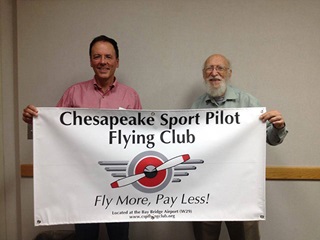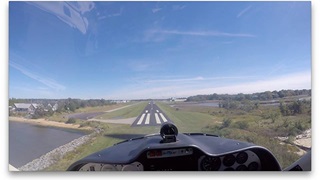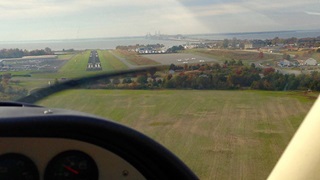
Dan Brown was at a point where he needed to fly as a sport pilot because of medical issues and he didn’t want the cost of owning an aircraft by himself. Helen Woods owned a flight school and was looking to restructure her business model to balance the needs of student pilots with those who rent, as well as create a more stable cash flow during the winter when there is less flying.
The result is the creation of the Chesapeake Sport Pilot Flying Club, which could serve as a model on how flight schools and clubs can partner together to build a strong aviation community.
Chesapeake Sport Pilot is the largest Light Sport flight school in the country with more than 20,000 hours on Light Sport Airplanes, Helen said. Located at Bay Bridge Airport (W29) in Stevensville, Maryland just east of Annapolis, CSP averages between 50 and 70 students in a normal year. It maintains a fleet of two Sky Arrows, two Tecnam P92 Eaglets, two Van’s RV-12s, and a Searey.
Dan has been flying with CSP for the past seven years. He already had a pilot’s license but the Taylorcraft he was flying at the time was in the shop and he wanted something else to fly, so he went to CSP and got checked out in a couple of its airplanes.
Dan and Helen, along with a few other pilots who flew with CSP have been talking about starting a flying club for a while and in September 2015 they launched the Chesapeake Sport Pilot Flying Club with a Tecnam P92 Eaglet purchased from the flight school.
“It was basically started by both Helen from Chesapeake Sport Pilot and ourselves to find a way to make flying more affordable and to make the aircraft available to people who need to fly as sport pilots,” Club President Dan Brown said.
 Creating Economic Stability
Creating Economic Stability
Helen bought Chesapeake Sport Pilot, an AOPA award winning flight school, from the previous owner last year. “The dynamics of the school were always quite robust,” Helen said. “But the financial foundation of the school was not nearly in as robust of a condition. I really had to restructure the business model.”
There were two goals to finding a business model that worked. One was creating a steady cash flow. The other was balancing the competing needs of a student pilot with that of a licensed pilot who is looking to rent an aircraft.
One of the challenges of operating a flight school where winter weather limits flying is that it becomes a seasonal business. Flight schools make money only when aircraft are flying, but the bills come due each month. “You have to even out cash flow throughout the year, which is extremely difficult because of the weather we have in this area,” Helen said. “The flying club is one of a number of things I’ve done to try to even out cash flow.”
Flying clubs have a much higher stability rate than flight schools because dues remain constant throughout the year. That steady income covers the fixed costs, such as hangar or tie down fees, office rent, and insurance, regardless of whether or not anyone flies.
By creating the CSP Flying Club and moving some rental customers out of the flight school and into the flying club was the answer. The club member dues are used in part to pay the flight school a management fee to cover the cost of sharing a building and office staff. That management fee allows the flight school to even out some of its cash flow.
Balancing Competing interests
The cash flow was only one aspect of the new business model. The other was making aircraft available for different missions.
“The second side of the whole problem is our job as a flying school is to teach people how to fly. Once they learn to fly, they want to go places and do things,” Helen said. “However, if they take the plane for the whole weekend to New York, then all of the students who are flying that particular plane are having to skip that entire weekend for their flight lessons and they lose the continuity of training. They fall backward and if they have enough gaps in their continuity of training they tend to drop out.”
 By setting up the flying club, people are able to graduate from the flight school and move into the flying club where they are then able to take day trips or even go overnight. They can do what they want and have a lot better access to planes without competing with students for the plane, Helen said.
By setting up the flying club, people are able to graduate from the flight school and move into the flying club where they are then able to take day trips or even go overnight. They can do what they want and have a lot better access to planes without competing with students for the plane, Helen said.
Students are no longer penalized by people taking the airplane all day, and those who rent don’t have to book out a couple months ahead of time to get around all the students that are booked. “It was a real problem having renters and students competing for the same aircraft and this way they are no longer competing with each other,” Helen said.
It also helps prevent a situation in which someone takes a plane on a trip and gets weathered in for a few days. “It doesn’t hurt the club financially to have the airplane sitting on the ground 200 miles away for a week, where as in a [flight school] rental situation it definitely does,” Dan said.
The way the club is structured, members must have their sport pilot license or higher to join. Therefore, the club won’t take business away from the flight school. If members want to work on advanced ratings, they may do so in the club Tecnam using CSP’s flight instructors.
Entry For Ownership
Another benefit of creating the flying club is that new Sport Pilots have an easier path to ownership. One of the biggest problems in the Light Sport Industry is that a decent conditioned LSA is more than twice the cost of an older model Cherokee or Cessna 172. So for $4,800, a pilot can buy an equity share in the CSP Flying Club’s Tecnam, which is refundable upon leaving the club.
 “It’s very difficult to get into ownership in the light sport world unless you have a decent amount of money,” Helen said. “That’s one of the things that we really try to push—not just Sport Pilot, but ways people can get involved with ownership at a much more reasonable rate.”
“It’s very difficult to get into ownership in the light sport world unless you have a decent amount of money,” Helen said. “That’s one of the things that we really try to push—not just Sport Pilot, but ways people can get involved with ownership at a much more reasonable rate.”
And the club just introduced a financing option where someone can put down $800 and the club will loan them the rest of the buy-in amount at 8 percent interest for a two-year loan. “We just came out with that and we have three prospects who are very interested who were holding back on joining the club because of the up front money,” Dan said.
The club is only a few months old but it offers an intriguing model of partnership that could strengthen both flight schools and flying clubs with the end result of producing a larger, stronger general aviation community.
“It solves a lot of problems,” Helen said. “We’re really excited about the whole thing. It works out well for all of us.”
Factsheet
| Name | Chesapeake Sport Pilot Flying Club |
| Location | Bay Bridge Airport (W29), Stevensville, MD |
| Website | http://cspflyingclub.org |
| Year formed | September 2015 |
| Aircraft | 2008 Tecnam P92 Eaglet ($55/hr) Rates are Hobbs time, wet. |
| Joining fee | $4,800 equity share (refundable when member leaves) $130 application fee |
| Monthly dues | Currently $270 per month, expected to drop to $155 per month as more members join |
| Membership | 6 |
| Scheduler | Greenfolder.com |